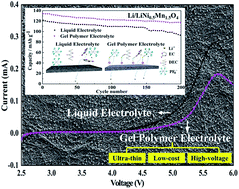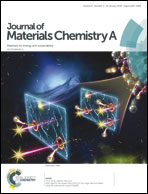Polyethylene-supported ultra-thin polyvinylidene fluoride/hydroxyethyl cellulose blended polymer electrolyte for 5 V high voltage lithium ion batteries
Abstract
A new polyethylene (PE)-supported ultra-thin blended polymer electrolyte based on polyvinylidene fluoride/hydroxyethyl cellulose (PVDF/HEC) was prepared by a simple dipping method for 5 V high voltage lithium-ion batteries (LIBs). The performances of the prepared membranes and the resulting GPEs were investigated by scanning electron microscopy, electrochemical impedance spectroscopy, linear potential sweep voltammetry, and charge–discharge cycling. The effects of the ratio of PVDF to HEC on the performance of the composite separator were further discussed. It was found that PE-supported polymer separators (PVDF : HEC = 3 : 1, by weight) present the best mechanical, thermal and wettability performance. The ionic conductivity of this GPE is 0.78 mS cm−1, which is much higher than that of PE separators (0.39 mS cm−1) at room temperature. The electrochemical stability of this GPE can reach up to 5.25 V (vs. Li/Li+). A LiNi0.5Mn1.5O4 cathode with this GPE exhibits a superior cycling stability and rate performance at room temperature. This suggests that the polyethylene (PE)-supported ultra-thin blended polymer electrolyte can be used for 5 V LIBs due to its good performance, low cost and strong operability.



 Please wait while we load your content...
Please wait while we load your content...